
About UsThe Numismatic Bibliomania Society is a non-profit organization promoting numismatic literature. For more information please see our web site at coinbooks.org SubscriptionsThose wishing to become new E-Sylum subscribers (or wishing to Unsubscribe) can go to the following web page link MembershipThere is a membership application available on the web site Membership Application To join, print the application and return it with your check to the address printed on the application. Membership is only $20 to addresses in the U.S., $25 for First Class mail, and $30 elsewhere. For those without web access, write to: David M. Sundman, Treasurer AsylumFor Asylum mailing address changes and other membership questions, contact David at this email address: dsundman@LittletonCoin.com SubmissionsTo submit items for publication in The E-Sylum, just Reply to this message, or write to the Editor at this address: whomren@gmail.com
BUY THE BOOK BEFORE THE COIN |
- WAYNE'S WORDS: THE E-SYLUM MARCH 23, 2014
- KOLBE & FANNING ANNOUNCE THREE-DAY WEB SALE
- NEW BOOK: BIBLIOGRAPHY OF U.S. BANK HISTORIES
- NEW BOOK: WORLD REPLACEMENT NOTES
- NEW BOOK: THE LINCOLN CENT RPM BOOK VOL. 2
- NEW BOOK: FORGED IN PHILADELPHIA
- NEW BOOK: TWISTED TALE OF COVER-UP AND DECEIT
- NEW BOOK: CENTRAL STATES 75TH ANNIVERSARY REDBOOK
- NEW BOOK: ERIK WALLER COLLECTION OF MEDICAL MEDALS
- EL SITIO NO. 10 PUBLISHED
- NEW BOOK: MONEDAS DE ORO QUE CIRCULARON EN URUGUAY
- MICHEL PRIEUR 1955-2014
- OLIVER LAWRENCE LISOT 1927-2013
- TOKENS OF VAUX HALL TAVERN, BALTIMORE
- NOTES FROM E-SYLUM READERS: MARCH 23, 2014
- COIN BOARD NEWS NUMBER 30 PUBLISHED
- GOVERNMENT DISPUTES 1974-D ALUMINUM CENT OWNERSHIP
- QUERY: EARLIEST USE OF TERM 'WITCH PIECE' SOUGHT
- JEAN-PAUL DIVO: PAPER MONEY CONVERT
- ROYAL MINT TO INTRODUCE NEW ONE POUND COIN
- THE ROYAL MINT'S ISIS ANTI-COUNTERFEITING SYSTEM
- DUTCH MINT COUNTERFEITED BRITISH POUND COINS
- CURVED BASEBALL COMMEMORATIVE COIN BEING STRUCK
- HOW THE U.S. MINT MADE THE BASEBALL COIN
- JOHN HUFFMAN AT THE INVASION OF LOUISVILLE
- THE NEW YORK STAMP & COIN COMPANY
- BOSTON MUSEUM OF FINE ARTS ANCIENT COINS GALLERY
- THE 500 EURO BIN LADEN BANKNOTE
- IMPERIAL FABERGE EGG FOUND AT 'FLEA MARKET'
- 'MYSTERY SHOPPERS' RECRUITED TO PASS COUNTERFEITS
- MONEY ARTIST MARK WAGNER'S DOLLAR BILL COLLAGES
- SLATE ARTICLE ON MONEY ARTIST MARK WAGNER
- CBS NEWS SEGMENT ON OLD AND NEW CURRENCY DESIGNS
- FEATURED WEB PAGE: COINS OF THE KINGS OF FRANCE
Click here to access the complete archive
To comment or submit articles, reply to whomren@gmail.com
WAYNE'S WORDS: THE E-SYLUM MARCH 23, 2014

New subscribers this week include David Ellison, Keith Kelman, Lawrence Cutler, and Jesse Goplen. Welcome aboard! We have 1,708 email subscribers.
This week we open with an update from Kolbe & Fanning, followed by NINE new and recent numismatic books and publications. Wow! Next up are tributes to numismatists Michel Prieur and Oliver Lawrence Lisot.
Other topics include the tokens of Vaux Hall Tavern (Baltimore), the 1974-D Lincoln cent, 'Witch Pieces', the New York Stamp & Coin Company, money artist Mark Wagner, and the Royal Mint's new pound coin.
To learn more about U.S. bank histories, replacement notes, repunched mintmarks, coin boards, folded coins, curved coins and counterfeit coins, read on. Have a great week, everyone!
Wayne Homren
Editor, The E-Sylum
KOLBE & FANNING ANNOUNCE THREE-DAY WEB SALE
Kolbe & Fanning Numismatic Booksellers are discounting all 1,200+ books and catalogues in their online bookstore for three days from Sunday, March 23 through Tuesday, March 25 at numislit.com.
Apply code SALE at checkout to receive the discount.
During that time, all items on the Kolbe & Fanning website will be available for 20% off the listed price. In addition, domestic orders will be shipped for a flat fee of $5 per order, regardless of the number of books included. (International shipments will continue to be billed at the actual cost.)
Kolbe & Fanning regularly add material to their ever-growing website, which features works on all aspects of numismatics. Items range in price from $5 to $2000. Categories include:
- Ancient Greek
- Ancient Roman
- Asian
- Islamic
- Celtic
- Jewish
- Latin-American
- Russian
- Medieval
- Byzantine
- Modern Foreign
- United States
- Medals
- Sale Catalogues
- Periodicals
- Bibliography
- Paper Currency
- and others.
Check out the sale now at www.numislit.com .
NEW BOOK: BIBLIOGRAPHY OF U.S. BANK HISTORIES
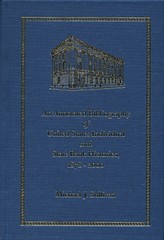 New Book: An Annotated Bibliography of United States Individual and State Bank Histories 1878-2000 by Michael J. Sullivan, designed by the Ascenius Press and distributed by Charles Davis, 395 pages, text illustrations, blue cloth. Citing 1651 entries, the author uses 27 years of collecting expertise to raise the bank history to the level of a necessary adjunct of paper money collecting - “several instances exist where an illustrated bank note has not been observed by collectors.” Bibliographical informational and locations of all citations listed are noted.
New Book: An Annotated Bibliography of United States Individual and State Bank Histories 1878-2000 by Michael J. Sullivan, designed by the Ascenius Press and distributed by Charles Davis, 395 pages, text illustrations, blue cloth. Citing 1651 entries, the author uses 27 years of collecting expertise to raise the bank history to the level of a necessary adjunct of paper money collecting - “several instances exist where an illustrated bank note has not been observed by collectors.” Bibliographical informational and locations of all citations listed are noted.
The regular edition of 100 numbered copies, each with a fine letterpress bookplate, bound in blue cloth is available at $95.00 plus $7.00 shipping. A quarto sized special edition limited to 15 copies with illustrations in color is currently being bound by Sam Ellenport (retired owner of Boston’s Harcourt Bindery). Priced at $575.00, it will be available in the late Spring. Orders should be made through Charles Davis, Box 547, Wenham, MA 01984 or through his web site numisbook.com .
NEW BOOK: WORLD REPLACEMENT NOTES
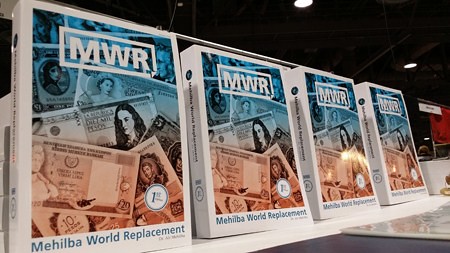
The Arabic Chapter of International Banknote Society (IBNS) has published books about the banknotes including of Egypt, Kuwait and Libya. Their next book covers world replacement notes. In an earlier E-Sylum article, Dr. Ali Mehilba of Egypt wrote:
A replacement banknote is a banknote that is printed to replace a faulty one and is used as a control mechanism for governments or monetary authorities to know the exact number of banknotes being printed. As quality control finds defective notes in the printing process after the serial number has been overprinted, they are taken out with their serial number written down and replaced with another banknote printed specifically for this purpose, so that the amount of banknote being printed stays the same in each production batch. This saves time and money compared to re-printing exactly the same serial number that was used before. It is rare that the replacement banknote has the same serial number as the original faulty one. A replacement note will have its own serial numbering system that separates it from the normal numbering system.
The book is now available. Dr. Mehilba writes:
My reference book was released at Long Beach: 592 colored pages covering the replacement notes for most countries. The book received great feedback from many collectors, dealers, auctioneers and graders. The Book is sold for $65 plus shipping.
For more information, or to order, see:
MEHILBA WORLD REPLACEMENT BOOK NOW AVAILABLE
(www.pmgnotes.com/news/viewarticle.aspx?IDArticle=3862)
The World's
Most Comprehensive Replacement Notes Catalog
(www.worldreplacement.com/)
To read the earlier E-Sylum article, see: HELP SOUGHT FOR UPCOMING BOOK ON REPLACEMENT NOTES (www.coinbooks.org/esylum_v14n30a04.html)

NEW BOOK: THE LINCOLN CENT RPM BOOK VOL. 2
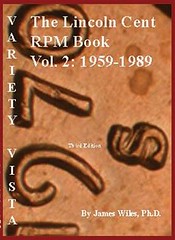 Have you been waiting for a complete update to The Lincoln Cent RPM Book? Wait no longer. Volume 2 of the Third Edition is now released in E-Book format, completing The Lincoln Cent RPM E-Book set. While Volume 1 focused on Wheat Cent RPMs, Volume 2 focuses on Memorial Cent RPMs. Together, these two volumes take Lincoln Cent RPM collecting to an all new level.
Have you been waiting for a complete update to The Lincoln Cent RPM Book? Wait no longer. Volume 2 of the Third Edition is now released in E-Book format, completing The Lincoln Cent RPM E-Book set. While Volume 1 focused on Wheat Cent RPMs, Volume 2 focuses on Memorial Cent RPMs. Together, these two volumes take Lincoln Cent RPM collecting to an all new level.
In The Lincoln Cent RPM Book Volume 2: 1959-1989, you will find photos of all the die markers for a given variety. And not just the die markers for one stage, but for every stage, with only a few exceptions. Ninety-eight percent of all the Memorial Cent RPM photos have been retaken using high quality, high magnification, full color, digital images. That is 5200+ images, all at your fingertips.
Variety Vista E-Books are bigger, better, and easier to use than traditional print books. And these RPM E-Books will make attributing your RPM collection an incredible joy. Volume 2 contains all 481 Memorial Cent RPMs listed in the CONECA files and it includes the latest population and pricing guide as well. It's my first choice when attributing Memorial Cent RPMs and I bet it will be yours too!
The Lincoln Cent RPM Book Volume 2 is available for immediate delivery. And best of all, it's just $30 + $4 shipping and handling. Send check or money order (payable to James Wiles) to 1490 Trail View Lane, Frisco, TX 75034. Or for your convenience, you can Paypal jameswiles@sbcglobal.net with the funds.
James writes:
RPM stands for RePunched Mintmark. Mintmarks were punched into the working dies by hand up to 1990, when the mint began placing them on the master die. This hand-punching resulted in many dies showing a multiple image on the mintmark. Either the punch bounced with the hit from the mallet or the technician decided the initial hit wasn't deep enough and then misaligned the punch for subsequent hits.
NEW BOOK: FORGED IN PHILADELPHIA
Joel Orosz writes:
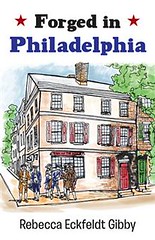 Thanks to a heads up from Cynthia Smith, I have learned that a new historical novel, Forged in Philadelphia, has just been published. The book focuses on the life of Adam Eckfeldt in 1792, including Adam's interactions with the early Mint and with the Washington family. It is based on considerable research, although the author stresses that it is a novelization, with material that is dramatized, as opposed to purely factual.
Thanks to a heads up from Cynthia Smith, I have learned that a new historical novel, Forged in Philadelphia, has just been published. The book focuses on the life of Adam Eckfeldt in 1792, including Adam's interactions with the early Mint and with the Washington family. It is based on considerable research, although the author stresses that it is a novelization, with material that is dramatized, as opposed to purely factual.
This alone would be of interest to numismatists, but what makes this book especially intriguing is the fact that it is authored by an Eckfeldt descendant, Rebecca Eckfeldt Gibby. Her status as a family member gives her access to details about the family that are not widely known. For example, the cover art is a depiction--an imaginative reconstruction--of John Jacob Eckfeldt's blacksmith shop at "The Sign of the Sickle."
The other day I received a package from Ms. Rebecca E. Gibby that contained a copy of her new book, Forged in Philadelphia, the cover of which is illustrated here. It is published by Abbott Press, a division of Writer’s Digest, and can be accessed on the Internet.
The author, born and raised in Philadelphia, draws upon tradition of her Eckfeldt heritage, particularly Adam Eckfeldt, a blacksmith who loaned his talents in machining and other things to the United States Mint after it was formed, following the Mint Act of April 2, 1792.
The story, loosely based on history and tradition, takes the form of a novel, with various members of the Eckfeldt family and others associated with the Mint taking speaking parts, engaging in discussions, wondering how to approach President Washington with the idea of his donating silver implements and tableware to melt down for 1792 half dismes (folklore, we know), and so on.
The story, comprising 102 pages, is a light and interesting read. For a numismatist it invites further exploration of the Mint in Philadelphia and perhaps the incentive to purchase from Whitman Publishing, LLC, a copy of The Secret History of the First U.S. Mint by Joel Orosz and Leonard Augsburger.
The year is 1792, and although American independence has been secured, individual freedoms are still elusive for many. Adam Eckfeldt is an apprentice to his father’s blacksmith business. For his father Jacob, there is no question the young man will someday replace him, but Adam has other aspirations.
The Eckfeldt family slave has his own dreams. Christian yearns for emancipation. This yearning only increases when he falls in love with Ona Judge, maid to Lady Martha Washington.
In post-revolutionary Philadelphia, Adam and Christian must forge the pathway to their dreams. These friends navigate the unfamiliar territory of the early abolitionist movement as well as the ins and outs of the Washington household. Their unlikely friendship and their loyalties are tested as they each face dilemmas that will alter the course of their young lives.
To read the complete Bowers article, see:
Forged in Philadelphia
(www.stacksbowers.com/NewsMedia/Blogs/TabId/780
/ArtMID/2678/ArticleID/64416/Forged-in-Philadelphia.aspx)
To order from Abbott Press, see: Forged in Philadelphia (bookstore.abbottpress.com/Products/SKU-000702667/Forged-in-Philadelphia.aspx)
NEW BOOK: TWISTED TALE OF COVER-UP AND DECEIT
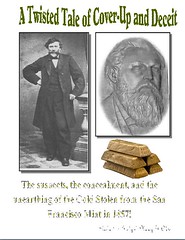 Over one hundred and fifty-seven years ago, in 1857, $152,000 in gold came up missing from the United States Branch Mint in San Francisco. Fingers pointed at the man in charge of the Melting and Refining Department, and he tried to defend himself by offering most of his assets to make up for the unexplained sizeable gold loss. Four years later, he was found not guilty due to lack of evidence.
Over one hundred and fifty-seven years ago, in 1857, $152,000 in gold came up missing from the United States Branch Mint in San Francisco. Fingers pointed at the man in charge of the Melting and Refining Department, and he tried to defend himself by offering most of his assets to make up for the unexplained sizeable gold loss. Four years later, he was found not guilty due to lack of evidence.
After all the investigation and trial, the person(s) responsible for the loss was never discovered. As a result, the Government ceased pursuing the affair and wrote off the loss as unrecoverable. However, a very interesting, and quite surprising, event occurred 35 years later that revealed overwhelming evidence as what might have been the true fate of the gold; someone secreted it away thinking it would never be found. A door, which had been shut tight to conceal the true culprit, and even the discovery of the missing gold itself, is now being opened.
This 87-page ‘Treatise’ provides very convincing circumstantial evidence, that point to a very likely culprit of one of the most talked about thefts of mint history. Found by chance in an old local San Francisco Bay Area newspaper, this surprising event has been the impetus for untangling a case that has been cold for 157 years. Intensive research into the National Archives (on both coasts), libraries of San Francisco, Sacramento, Oakland, and the perusal of dozens of pages of old newspaper reports have been used to put his work together.
This treatise is presently spiral bound, and currently is made to order, which takes some time. However, if interest demands, the authors will have more copies printed for inventory and availability.
The pre-publication cost for “A Twisted Tale of Cover-Up and Deceit” is $23.00, which includes shipping and handling. Inquiries of same may be made to the authors at – noliver146@sbcglobal.net .
If interested, please mail a check or money order to:
Richard G. Kelly
26746 Contessa St.
Hayward, CA 94545-3150
NEW BOOK: CENTRAL STATES 75TH ANNIVERSARY REDBOOK
 "The Central States Numismatic Society announces the publication and sale of a Special Hard bound Edition of the Whitman Publishing Red Book. In celebration of the Society's 75th Anniversary, 500 copies of the special Red Book with the Central States Logo and 75th Anniversary designation on the cover will be produced. The Red Books may be purchased beginning April 23, 2015 at the Society's 75th Anniversary Convention in Schaumburg, IL, April 23-26, in the Renaissance Convention Center.
"The Central States Numismatic Society announces the publication and sale of a Special Hard bound Edition of the Whitman Publishing Red Book. In celebration of the Society's 75th Anniversary, 500 copies of the special Red Book with the Central States Logo and 75th Anniversary designation on the cover will be produced. The Red Books may be purchased beginning April 23, 2015 at the Society's 75th Anniversary Convention in Schaumburg, IL, April 23-26, in the Renaissance Convention Center.
The price of the Red Book at the convention will be $15.00. Copies can be mailed anywhere in the United States for $20.00. Contact Ray Lockwood, CSNS Education Director, at:sunrayofmarion@aol.com or 765-664-6520 for ordering instructions and details about the Special Edition Red Book."
EMPLOYMENT OPPORTUNITY!
Live and Work in Southern CaliforniaStack’s Bowers Galleries offers an important employment opportunity for the right person. We are seeking an experienced numismatist in the American series—coins, tokens, medals, and paper money—to work with our “dream team” of catalogers, building on the tradition of the Ford, Eliasberg, Bass, Cardinal, Norweb, Battle Born and other great collections.
If you can write in an authoritative and compelling manner with a high degree of accuracy, this may be just right for you! You will be working in Irvine, a modern community in dynamic Orange County, California—one of the finest areas to live. We offer generous benefits including medical and dental coverage, 401K plan, and more. Our offices are in our own modern, state-of-the art building with all amenities.
If you would like to be considered for this position please contact Q. David Bowers by mail or by email with your resumé, samples of your past writing (on numismatics or other subjects), and salary requirements: Mail to the attention of Q. David Bowers, PO Box 1804, Wolfeboro, NH 03894. Email to: Ckarstedt@stacksbowers.com
NEW BOOK: ERIK WALLER COLLECTION OF MEDICAL MEDALS
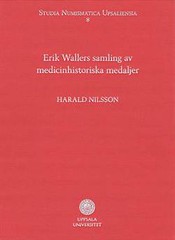 Harald Nilsson, Erik Wallers samling av medicinhistoriska medaljer, Studia Numismatica Upsaliensia 8. Uppsala University, Uppsala, 2013. 517 p., images in colour, hardcover, 25.8 x 20 cm. ISBN: 978-91-554-8701-0. 425 SEK (= 48 euros) + postal charges.
Harald Nilsson, Erik Wallers samling av medicinhistoriska medaljer, Studia Numismatica Upsaliensia 8. Uppsala University, Uppsala, 2013. 517 p., images in colour, hardcover, 25.8 x 20 cm. ISBN: 978-91-554-8701-0. 425 SEK (= 48 euros) + postal charges.
Hubert Emmerig has published online a bibliography of ‘Medicina in Nummis’ running to incredible 86 pages. In these 86 pages he already included the most recent reference work by Harald Nilsson, an impressive and comprehensive catalogue of the Erik Waller (1875-1955) collection which was published in late 2013. The catalogue comprises 735 medals, all of them related to medical-historical aspects.
Harald Nilsson stands in a tradition which goes back many centuries. In 1893 Adolph Weyl published the catalogue of a collection owned by Sanitätsrath (Austrian title; a sort of “medical consultant”) Dr med. Carl Ludwig from Duisburg. Ever afterwards physicians have collected medals with medical-historical subjects and scholars have published catalogues of these collections. Just think of the famous Dr Joseph Brettauer and his author Eduard Holzmaier, or today Erik Waller, a Swedish surgeon, collector of books and creator of an important collection of medals related to medical-historical subjects now presented in a catalogue by Harald Nilsson.
The description of every item starts with its number and subject. Then follows a detailed description of obverse and reverse. You will quickly learn that little bit of Swedish needed to use the catalogue. ‘Präglingsår’ means ‘year of issue’, ‘Konstnär’ is the ‘artist’, and ‘Diameter’ the ‘diameter’.
Actually, in the end the language is not so relevant as every single object is photographed.
You can buy this book at 425 SEK (= 48 euros) + postal charges on the internet.
To purchase the book, see: 0008: Erik Wallers samling av medicinhistoriska medaljer (acta.mamutweb.com/Shop/Product/0008-Erik-Wallers-samling-av-medicinhistoriska-medaljer/diva2:665237)
To view or print the free bibliography, see: Bibliographie zum Thema „Medicina in Nummis“ (ww2.smb.museum/ngb/files/Medicina_in_nummis_14.pdf)
To read the complete article, see: Medicine and Medals (muenzenwoche.de/en/News/4?&id=2674)
EL SITIO NO. 10 PUBLISHED
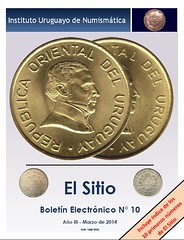 “El Sitio” Nº 10 contains two interesting numismatic articles:
“El Sitio” Nº 10 contains two interesting numismatic articles:
1) The die varieties of the $ 1 and $ 2 Uruguayan coins, minted in 1994 in the Buenos Aires Mint House, by Horacio Morero, president of the Instituto Uruguayo de Numismatica.
2) The private money papers issued by “The Drugstore of Cranwell”, by Javier Avilleira.
There are two pages as well -with several pictures- dedicated to the annual New Year’s Eve party developed at December 11th, 2013, in the Noa-Noa Club.
Finally, in the last five pages, the reader is presented with a complete index of the numismatic articles, conferences, dissertations and other events that were covered throughout the first ten numbers of “El Sitio”.
To read the complete issue, see: www.monedasuruguay.com/bib/bib/sitio10.pdf
NEW BOOK: MONEDAS DE ORO QUE CIRCULARON EN URUGUAY
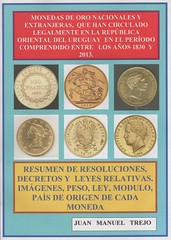 “Monedas de oro nacionales y extran-jeras, que han circulado legalmente en la República Oriental del Uruguay en el período comprendido entre los años 1830 y 2013”
“Monedas de oro nacionales y extran-jeras, que han circulado legalmente en la República Oriental del Uruguay en el período comprendido entre los años 1830 y 2013”
by Juan Manuel Trejo
The new book was issued in December 2013 by the Uruguayan numismatic Juan Manuel Trejo, born in Santa Lucía, San José Department. With 50 pages, the book is a briefing of resolutions and laws issued between 1830 and 2010 related to the gold coins (Uruguayan and foreign) that circulated in Uruguay.
To read the complete issue, see: www.monedasuruguay.com/bib/bib/sitio10.pdf
THE BOOK BAZARRE
MICHEL PRIEUR 1955-2014
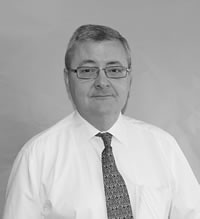 It is with much sadness and distress that I inform E-Sylum readers of the recent passing of Michel Prieur, one of the founders of CGB, who I have known for many years. In fact, he was one of the first numismatists I ever e-mailed, even before I had my own e-mail address. To me, he was a true scholar and friend, and the face of French numismatics. But not only French. He was also a world authority on Syro-Phoenician tetradrachms, as demonstrated by the book, A Type Corpus of the Syro-Phoenician Tetradrachms and their Fractions from 57 BC to AD 258 (2000), which he wrote with Karin Prieur. It remains the standard reference in the field.
It is with much sadness and distress that I inform E-Sylum readers of the recent passing of Michel Prieur, one of the founders of CGB, who I have known for many years. In fact, he was one of the first numismatists I ever e-mailed, even before I had my own e-mail address. To me, he was a true scholar and friend, and the face of French numismatics. But not only French. He was also a world authority on Syro-Phoenician tetradrachms, as demonstrated by the book, A Type Corpus of the Syro-Phoenician Tetradrachms and their Fractions from 57 BC to AD 258 (2000), which he wrote with Karin Prieur. It remains the standard reference in the field.
I have very little information to offer at this time, but I see Wikipedia claims he had died on March 21. I have doubts that this is correct as this CGB blog posting is dated March 20: http://blog.cgb.fr/michel-prieur-nous-a-quittes,6160.html
I had planned to write an article on the French Sower (La Semeuse) one-franc coins with his help—which he was always graciously willing to extend—but now I do not know if I have the heart to complete the project.
Michel did more than any person I know of to popularize French coin collecting and research, even to the English speaking segment of the hobby. He had both tried in vain to find an English translator for CGB's marvelous Le Franc coin guide (modeled after Whitman's "Red" and "Blue" books) and an American distributor for the French version.
The reason for searching out an American distributor was the costly shipping fees imposed on books mailed to the US which he badly wanted to remedy. I was struck by Michel's honesty when he once suggested to me not to buy Le Franc directly from CGB, but from some other bookseller, on account of the unreasonable transatlantic shipping costs that they were forced to charge.
But Michel's efforts to promote the hobby weren't only limited to traditional means. He was a huge advocate of bringing French numismatics into our 21st century world. CGB's beautifully designed website is a testament to that. Their monthly online periodical, Le Bulletin Numismatique, published since 2004, is a reason alone for learning to read French. I find it amazing how skillfully crammed each issue of Le BN is with articles and news on numismatic topics ranging all the way from ancient to modern. As is so characteristic of Michel, all of this is offered freely to subscribers.
Some say M. Prieur was opinionated, and I believe they are right, but in all the correspondences I have had with him over the years, his opinions were always received with interest and respect as were mine. Frankly, there was very little, if anything, to disagree with as he said what needed to be said—with wit and conviction. I pray that this boldness is carried on by CGB. I shudder to think what French numismatics, and numismatics in general, would be like without their care and dedication to the hobby.
It grieves me to lose yet another dear numismatic friend in such a short time, and one following in the large wake of my stepmother, who went to heaven on February 15.
I had meant this letter to be very brief, but I see I was carried away by grief for my friend... adieu.
OLIVER LAWRENCE LISOT 1927-2013
Oliver Lawrence Lisot-DECEASED
December 8, 1927 to December 27, 2013
AKA Oliver, Levo, Nani, Larry, Nono, and “The Grizz”.
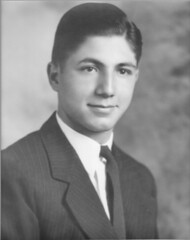
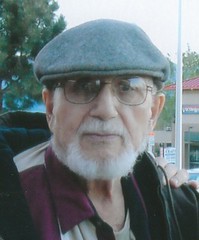
Oliver Lawrence Lisot was 86 years when he passed away on December 27, 2013 after a long decline in his health. He suffered from degenerative discs in his spine. He was born of Italian heritage on December 8, 1927 in Denver, Colorado. He is survived by his wife of 63 years, Dorothy Sue Lisot, his three children Becky Sue Lisot, David Lawrence Lisot, and Danna Robert Lisot as well as his grandchildren Maxine Dorothea Lisot, Alexander Lawrence Lisot, Michael Lisot, and Monica Sue Lisot.
His life started with challenges that led to him being adopted by Oliver Lawrence and Magdalene Lisot who raised him in Aguilar, Colorado. His grandfather “Nono” Lisot helped raise him and became one of his heroes and role models in life. Oliver graduated from high school and enlisted in the Merchant Marines. He later transferred into the paratroopers. He finished his military career in the Army Reserves retiring as a Captain from the Chemical Corps.
He attended the University of Colorado where he attained his Bachelors degree. He later returned to the University of Colorado where he received his Masters degree in Chemical Engineering. While at the university he met his future wife Dorothy Sue Gunstream. They were married in 1949 and started a family that included three children, Becky Sue Lisot, born in Boulder, Colorado in 1950, David Lawrence Lisot, born in Saint Louis, Missouri in 1953, and Danna Robert Lisot, born in Aruba, Nederland Antilles in 1956.
Oliver worked different businesses that included American Cyanamid, Engelhard Industries, Shattuck Chemicals, Morrison Knudsen and other work situations. During his life he lived in Boulder, Colorado, St. Louis, Missouri, Milton, Florida, Houston, Texas, Denver, Colorado, Boise, Idaho, Dallas, Texas, and even Sierra Leone, Africa.
Oliver was a passionate collector of paper money items including bank notes, stock certificates, cigar labels and other historical items. His favorite areas were paper money of Mexico and Africa and anything with a bear on it. He was well known by many of the dealers in the numismatic hobby and ran a mail order business called Antique Carta and Collectorama for many years. He also assembled a large collection of miniature cars. Later in his life he sold all his holdings and focused on his family.
He experienced many wonderful times in his life, as well as, a fair share of disappointments. He had the classic relationship with wife and family. He climbed the corporate ladder while his beloved wife ironed the shirts and raised three children in the wild and consciousness changing 1960’s and 70’s. He had many hobbies including electronics, hunting and fishing, and photography and even raised several horses and cows.
In his retirement spending time with his grandchildren was his happiness. He became the same loving “Nono” that his Grandfather was to him. He faced a lot of pain as he aged due to the degenerative disc problems in his spine. Even under constant pain he always greeted family and friends with his classic Italian hug and kiss. He was deeply loved and will be greatly missed by everyone who was lucky enough to know him.
He was laid to rest at St. Joseph Catholic Church on February 14, 2014. In lieu of flowers or gifts the family wishes you to watch a sunset or spend some time in contemplation thinking about your life and your families and remember and think well of Oliver Lawrence Nono Papa Grizz Lisot.
God Bless.
David Lisot, son.
TOKENS OF VAUX HALL TAVERN, BALTIMORE
As a follow-up from last week's dinner, I believe you had asked if there were two Vaux Hall pieces that I had brought at two different times.
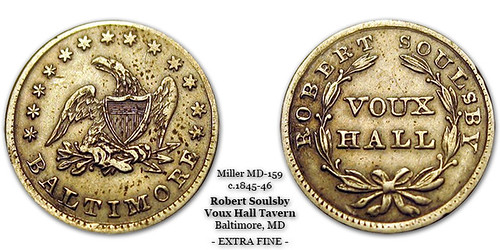
The first example was emitted by Robert Soulsby. He was the proprietor of Vaux Hall from 1839-1846.

The second was emitted by Benjamin Jury. He was the proprietor of Vaux Hall from 1848 to 1850. Both emissions are the size of half-dimes. It is surmised that they were worth 5-cents.
To read the earlier E-Sylum article, see: TOM KAYS' NUMISMATIC DIARY: MARCH 11, 2014 (www.coinbooks.org/esylum_v17n11a14.html)

NOTES FROM E-SYLUM READERS: MARCH 23, 2014
More Bald People on Coins Mark Borckardt writes:
The list of bald people on coins certainly must include the extraordinarily plentiful Winston Churchill Crown.

Image courtesy PCGS
Mel Wacks writes:
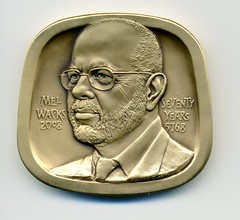 I always enjoy your e-newsletter. If you want to consider bald guys on medals, you can start with the excellent portrait of me done by Eugene Daub to celebrate my 70th birthday in 2008. It was issued by the Jewish-American Hall of Fame, for which I have served as director since 1968; it also celebrated the JAHF's 40th anniversary
I always enjoy your e-newsletter. If you want to consider bald guys on medals, you can start with the excellent portrait of me done by Eugene Daub to celebrate my 70th birthday in 2008. It was issued by the Jewish-American Hall of Fame, for which I have served as director since 1968; it also celebrated the JAHF's 40th anniversary
For more information on the Jewish-American Hall of Fame, see: www.amuseum.org/jahf/
To read the earlier E-Sylum article, see: BALD PEOPLE ON COINS (www.coinbooks.org/esylum_v17n11a10.html)
Turning Cents Into Pennies Paul Cunningham writes:
I have a question - from what country did the "pennies" spring that decorated the U.S. map of "pennies?"
I specialize in exonumia but I do know that the U.S. Mint produced cents, not pennies. Perhaps the same question should be directed at the folks at Heritage who gushed about the "pennies" being sold in a recent or upcoming sale (sorry, I didn't remember which). Are the "unwashed and uneducated" being taught that the Mint is producing pennies and not cents? Hmm. Best wishes and good health to all.
Larson wrote:
The March 11 Economy and Business item “For U.S. Mint, the high costs of small change” perpetuated the incorrect characterization of the “cent” as a “penny.” In fact, since 1793, the government has minted cents and has always called them that.
The current incarnation, the Lincoln cent, has been minted continuously since 1909. The U.S. Mint doesn’t call them “pennies.” This incorrect description of “penny” and “pennies” seems to persist no matter what anybody says about it. I think The Post might want to consider correcting that incorrect nomenclature.
To read the complete article, see: Two-cents on ‘pennies’ (www.washingtonpost.com/opinions/two-cents-on-pennies/2014/03/21/84e943d8-af90-11e3-b8b3-44b1d1cd4c1f_story.html)
To read the earlier E-Sylum article, see: MAN CREATES U.S. MAP MADE OF 24,000 PENNIES (www.coinbooks.org/esylum_v17n11a17.html)
On the Sir Francis Drake Myth Jim Bulmer writes:
 Hi All, I started my collecting career in Victoria, British Columbia in the mid 60's. Collecting English coins was popular and inexpensive, and there were, I wouldn't say lots, but several Edward VI shillings floating around in lesser grades (I had bought one for $7.50). The idea that Sir Francis Drake studied the west coast of North America around 1600 is a nice thought, but there's no concrete proof. A nice find, AND it feeds the myth....aren't coins fun?
Hi All, I started my collecting career in Victoria, British Columbia in the mid 60's. Collecting English coins was popular and inexpensive, and there were, I wouldn't say lots, but several Edward VI shillings floating around in lesser grades (I had bought one for $7.50). The idea that Sir Francis Drake studied the west coast of North America around 1600 is a nice thought, but there's no concrete proof. A nice find, AND it feeds the myth....aren't coins fun?
To read the earlier E-Sylum articles, see:
EDWARD VI SHILLING FOUND VICTORIA, BRITISH COLUMBIA
(www.coinbooks.org/club_nbs_esylum_v17n10.html)
ON THE SIGNIFICANCE OF FOUND COINS
(www.coinbooks.org/esylum_v17n11a09.html)
Carlos Saavedra Lamas Medals Eric Schena writes:
On Carlos Saavedra Lamas' Nobel Peace Prize, I have a very small anecdote. I think his estate must have been broken up some years ago as I used to have in my medal and decoration collection an award document for the Brazilian Grand Cross of the Order of the Southern Cross given to Lamas in 1936. It came to me from a European seller and I had it for a number of years before offering it to another collector. I wish I had pictures of the document.
To read the earlier E-Sylum article, see: 1936 NOBEL PEACE PRIZE TO BE AUCTIONED (www.coinbooks.org/esylum_v17n11a06.html)
Saddle Ridge Coin Hoard Claim John Regitko writes:
I remember going to California some years ago with a hoard of gold coins that I wanted to sell. When Alzheimer's set in, I forgot what I did with them. Obviously, it was the Saddle Ridge coin hoard. Can I have them back?
To read the earlier E-Sylum article, see: MORE ON THE "SADDLE RIDGE" GOLD COIN HOARD (www.coinbooks.org/esylum_v17n10a14.html)
A Gold Bicentennial Token

Howard Daniel writes:
Found the attached piece in Lot 590 in the Lyn Knight Spring Auction. It is something I have never seen before and likely of interest to Washingtonia collectors.
To view the complete lot description, see Gold Bicentennial Token (new.lynknight.com/ShowAuctionDetails.Asp?auction_Id=221702)
COIN BOARD NEWS NUMBER 30 PUBLISHED
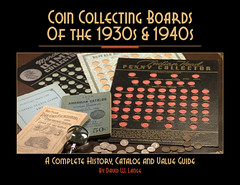 Attached are the latest issues of Coin Board News #30 and Coin Boards for Sale #130.
Attached are the latest issues of Coin Board News #30 and Coin Boards for Sale #130.
This is a very special announcement, as I'm suspending the mailing of additional price lists until further notice.
My publishing and promotion of coin boards has made the hobby so successful that the supply of new material has all but dried up. In many instances values have quadrupled, and all of the material is now in strong hands. In recognition of the difficulty in procuring new material, the attached list features my entire remaining inventory of coin boards. It's a whopping 10 pages and features entries from five of the seven coin board publishers.
I expect to continue publishing my quarterly newsletter, but I'm simply unable to procure enough coin boards to produce quarterly price lists.
Dave
David W. Lange
POB 110022
Lakewood Ranch, FL 34211
941-586-8670
http://coincollectingboards.com
TAKING A BREATHER I’ve been putting out this newsletter and my price lists of coin boards for more than six years now. They’ve both had a good run, but now it’s time to retire my price lists for the foreseeable future. I’m doing this for the simple reason that the market has matured to the point where there’s almost nothing new entering the pipeline. I’ve been unable to make any large purchases of nice boards for a couple of years now, and the handful of desirable pieces coming my way have been scooped up by want-list customers before I could add them to the next price list. I will continue to maintain want lists, but the present price list is the last for now.
On the positive side price advances for the better material have been remarkable since the 2007 publication of my book. For example, A Whitman First Edition board for Buffalo Nickels grading VF-NM that I sold right afterward for $33 is now valued at $100 in VF. That same board, if I could find one today, would move quickly at four times its 2008 price. By updating my value guide annually, I’ve created very knowledgeable collectors who now outbid me whenever choice pieces come up that I’d like to add to my inventory of boards for sale.
If the availability of coin boards increases over the next year or two I may resume sending out price lists, perhaps as an annual edition coinciding with each year’s update to the Check List & Value Guide. By the way, I plan to continue issuing that guide to anyone on my mailing list, and I expect that my newsletter will continue as a quarterly.
GOVERNMENT DISPUTES 1974-D ALUMINUM CENT OWNERSHIP

A man trying to auction off a rare 1974 aluminum penny claims in court that the government has no right to interfere by demanding return of the coin, which it has done.
Randall Lawrence and Michael McConnell used the Department of Treasury and Bureau of the Mint, seeking declaratory judgment that the government's claim to the penny, which was struck at the Denver Mint, is invalid.
Lawrence says that the coin he owns - the one the government is - was stamped at the Denver Mint, where his father, Harry Lawrence, worked for 20 years. Randall Lawrence says he found the coin among other possessions after his father's death in 1980.
Although Mint officials have stated that there is no evidence that any aluminum cents were struck at the Denver Mint in 1974, a former Denver Mint employee, Benito Martinez, told "Coin World" that he personally struck fewer than a dozen of the pennies as a die setter on aluminum planchets that had been provided by the Philadelphia Mint, the complaint states.
The Denver Mint struck a dozen pennies at most and then sent them to U.S. Mint headquarters in Washington, D.C., the lawsuit states.
"The small number and deliberate manner in which each was individually struck and sent directly to Washington further indicates that these were likely created to be presented to members of Congress and government officials, as were the Philadelphia-mint aluminum cents," Lawrence says in the complaint.
Of the dozen or so aluminum cents rumored to have been minted at Denver, only Lawrence's coin is known to exist. He wants to sell the penny at auction in April.
The U.S. Mint sent Lawrence a letter in February, "demanding the return of their aluminum cent. The letter stated that the government takes the position that, because Congress never issued an aluminum cent as legal tender, any aluminum cent remains property of the federal government, regardless of how long it has been in private hands," according to the complaint.
Lawrence denies it. "Thousands of coins minted by or for the U.S. Mint that were never 'issued' as legal tender have been widely and publicly collected and purchased and sold by coin collectors and dealers for over a century without any claims whatsoever from the government," he says in the lawsuit. "These include coins that were actually sold or 'gifted' by the Mint itself such as the aluminum cents, as well as coins that left the Mint under unknown circumstances."
Lawrence cites "pattern" coins - experimental pieces illustrating a proposed coin design or embodying a proposed change in coin composition, size or shape - which were never issued as legal tender, but have been widely collected and sold without interference from the government.
Other rare coins - including the 1913 Liberty Head nickel, the 1894-S dime, and the 1943 copper penny - were never officially issued as tender, but the government has made no attempt to reclaim them, the complaint states.
Lawrence and McConnell seek a declaratory judgment that the government has no legal claim to their 1974-D aluminum penny.
They are represented by Armen R. Vartian, of Manhattan Beach.
To read the complete article, see: Collector Says Uncle Sam Has no Right to His Rare 1974 Aluminum Penny (www.courthousenews.com/2014/03/18/66239.htm)
Perhaps the aluminum 1974-D Lincoln cent will not be sold at the Central States auction at the end of April.
The Mint wants it back.
A letter was sent Feb. 26 to owners Randall Lawrence and Michael McConnell demanding its return.
Sending this demand was Chief Counsel of the U.S. Mint Daniel Shaver.
The recipients of the letter filed suit in the U.S. District Court for the Southern District of California on March 14 seeking a declaratory judgment and jury trial on the issue.
Considering the great lengths the Mint has gone to in its recovery of 1933 $20 gold pieces, it perhaps is not surprising that it would take action regarding the 1974-D aluminum cent.
Will the two owners be able to keep the coin?
Even if they are, such a court judgment might not come in time for the April auction.
That would delay its ultimate sale.
If the Mint wins, the coin will disappear from collector view and perhaps be destroyed.
Whatever the outcome, the 1974-D aluminum cent has gotten the attention of collectors everywhere and its ultimate fate is a matter of keen interest.
To read the earlier E-Sylum articles, see:
MAN CAPTURES UNICORN: 1974-D ALUMINUM CENT
(www.coinbooks.org/esylum_v17n05a11.html)
ON THE LEGALITY OF OWNING ALUMINUM CENTS
(www.coinbooks.org/esylum_v17n06a17.html)
QUERY: EARLIEST USE OF TERM 'WITCH PIECE' SOUGHT
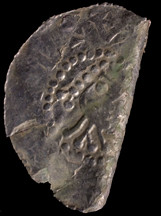

Folded coin
Having recently purchased a folded coin found at an 11th century “Viking” site in Latvia (images attached), I got to thinking about so-called Massachusetts silver “witch pieces.” In The Pine Tree Coinage of Massachusetts (American Numismatic Society, 1952), Sidney P. Noe wrote (p. 19, also Plate VI, a-c) “We are told that it was the superstitious belief of the time that wearing a bent coin afforded protection against the power of ‘witches.’” Not much authority here! No notice of “witch pieces” is taken by Crosby. Breen (Encyclopedia) adds nothing to Noe's statement.
More recently, Will Nipper (In Yankee Doodle’s Pocket, 2008, p. 166) was more skeptical. He wrote, “it often is difficult to separate fact from fiction when studying these pieces.... Many of the survivors were bent and later straightened, leaving a line of extra wear where the bend occurred. Legend says that they were bent as charms against the power of witches, though no contemporary supporting evidence seems to exist for this notion.” Bowers (Whitman Encyclopedia of Colonial and Early American Coins, 2009) appears to have ignored the subject entirely.
Louis Jordan, in “The Coins of Colonial and Early America” website, notes that “many Oak and Pine tree shillings [are] wavy and it was assumed they had been bent to protect against witches and later had been straightened out thus leaving a wavy appearance.” However, he writes, “the reason for the bending is that the coins were made on a roller press…. When the coin[s] came out of the two rollers they were not perfectly straight but rather slightly bent. So the bending is due to the coining process not because of the old superstition.” While Jordan is partly correct in that the Oak and large planchet Pine Tree coins were struck on a rocker (not roller) press, making them slightly sinusoidal instead of flat—see Christopher J. Salmon, The Silver Coins of Massachusetts, ANS, 2010, pp. 41-49—this is NOT the cause of the bend marks seen on Noe’s plate, which all have creaselike bends or edge folding. Attached are images of a hammered shilling of Edward VI, 1551-53, which shows somewhat similar flattening after having been creased twice from the reverse.
Bent and even folded silver coins, both Islamic and European, are commonly found among Viking hacksilver hoards and single finds from the 9th through the 11th centuries. In particular, silver coins in Polish finds of the first half of the 11th century are mostly found deformed, probably to test the silver quality of unfamiliar German coins, though Łukasz Czwojda (“A Tentative Interpretation of Peck Marks Upon Coins of the Viking Age,” Wiadomości Numizmatyczne LI (183), p. 28), argued that they “cannot be regarded as silver quality tests, [but] expressed the fears that accompanied the users of silver and were supposed to guard them against its negative influence.”
Later thin gold coins such as Florentine florins and Venetian zecchinos are also found bent and straightened, as are larger diameter English hammered silver coins. In all these cases, in my opinion, the purpose is to test that the metal is pure enough to withstand bending without cracking or breaking; “witches” are completely out of the picture.
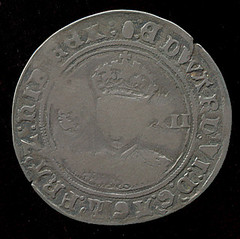

Creased shilling
Perhaps I am too cynical, but it is my suspicion that the term “witch piece” was invented by a coin dealer trying to get more money for a mutilated coin, and has no actual basis in history. Does anyone know when the term first appeared in an auction catalog or price list, and what authority—if any—was offered?
To read the Louis Jordan web page, see: FAQ: Witch Pieces (www.coins.nd.edu/ColCoin/FAQ/witchpieces.html)
JEAN-PAUL DIVO: PAPER MONEY CONVERT
 I have a treasured recollection of Jean-Paul Divo which E-Sylum readers might enjoy. While on active service at "Coin World" In Spring 1977, Courtney L. Coffing and I toured 11 European countries for CW, from Spain to Hungary, back westward to Ireland. Greeting us in Zurich, Switzerland, was John-Paul Divo, then one of Europe's best-known professional numismatists.
I have a treasured recollection of Jean-Paul Divo which E-Sylum readers might enjoy. While on active service at "Coin World" In Spring 1977, Courtney L. Coffing and I toured 11 European countries for CW, from Spain to Hungary, back westward to Ireland. Greeting us in Zurich, Switzerland, was John-Paul Divo, then one of Europe's best-known professional numismatists.
Courtney will be remembered by many for his numismatic writing career that began in the late 1930's, and as a pioneer in world paper money and especially as the "patron saint" of Notgeld. Paper was starting to take off thanks to publication of the Pick world paper money reference. (We later had an audience with Pick himself in his office in the Bayerische Hypobank in Munich).
Courtney had landed us a tour of an historic private paper money printer of Zurich, Orel Fuessli, a firm that had printed notes for several European countries as well as for the Swiss Confederation itself. Jean-Paul joined us for the tour, delivering an seemingly endless monologue AGAINST paper money collecting as we walked to the firm's offices! This great classical numismatist demanded to know "How can anyone collect these things, it's like collecting cigarette labels! It's ridiculous, I would never do this, what's the sense..." and on and on.
Our tour guide was a very sharp young woman staffer who entranced not only Courtney and me, but "Doubting Thomas" Jean-Paul Divo, who emerged from the Orel Fuessli headquarters as an outspoken ADVOCATE of paper money collecting, "I never guessed, I never knew, this is really wonderful!!!" And on and on!
Speaking of dividing by three, there is the old Irish tale of the three children who wanted to buy their father a birthday gift around 1914. They found a splendid watch fob but it cost 19 shillings! The oldest child told the jeweler, "Make it 21 shillings and we'll take it!!!" 21, of course, is divisible by three!
To read the earlier E-Sylum article, see: MORE ON JEAN-PAUL DIVO (www.coinbooks.org/esylum_v17n11a03.html)
THE BOOK BAZARRE
ROYAL MINT TO INTRODUCE NEW ONE POUND COIN
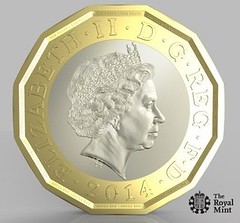 A new £1 coin, billed by the Royal Mint as the "most secure coin in the world", is to be introduced in 2017.
A new £1 coin, billed by the Royal Mint as the "most secure coin in the world", is to be introduced in 2017.
The move comes amid concerns about the 30-year old coin's vulnerability to counterfeiting, with an estimated 45 million forgeries in circulation.
The new coin is based on the design of the old threepenny bit, a 12-sided coin in circulation between 1937 and 1971.
A competition will be held to decide what image to put on the "tails" side of the coin.
In his Budget statement to the Commons, Chancellor George Osborne said: "The prerequisite of sound money is a sound currency."
He said the £1 coin was one of the oldest coins in circulation and had become "increasingly vulnerable to forgery".
"One in 30 pound coins is counterfeit, and that costs businesses and the taxpayer millions each year," Mr Osborne continued.
"So I can announce that we will move to a new, highly secure, £1 coin. It will take three years.
The current £1 coin was introduced in 1983 as part of the phasing-out of the Bank of England £1 note, which was withdrawn five years later.
Of the 1.5 billion estimated to be in circulation, as many as two million counterfeit ones are removed every year.
Adam Lawrence, chief executive of the Royal Mint, which is based in Llantrisant, south Wales, said the process could change the way coins were made in the future.
"It is our aim to identify and produce a pioneering new coin which helps to reduce the opportunities for counterfeiting, helping to boost public confidence in the UK's currency in the process."
David adds:
The proposal seems to have been welcomed here. I don't think the present pound coin is widely liked. There are many counterfeits. No-one has seen a counterfeited Two Pound coin so hopefully the new pound coin will be difficult to copy.
Suggestions by collectors for the reverse design include Britannia and the British Bulldog!
It is an interesting attempt by the Royal Mint to appeal to nostalgia for the brass threepenny bit.
Philip adds:
I thought readers might like this cartoon from today’s Metro, "Minted" is UK slang for "rich, wealthy".
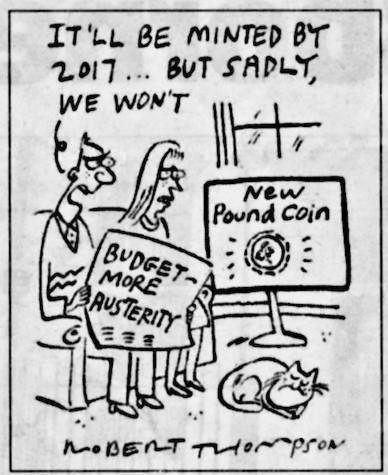
To read the complete article, see: New pound coin designed to combat counterfeiting (www.bbc.com/news/uk-politics-26632863)
THE ROYAL MINT'S ISIS ANTI-COUNTERFEITING SYSTEM

The Royal Mint has produced a prototype for a replacement £1 coin which utilises multiple layers of cutting edge technology and would allow the United Kingdom to rapidly reduce the rate of counterfeit coins entering general circulation.
The proposed £1 coin will be the most secure circulating coin in the world to date.
It will be constructed from two different coloured metals and contain an iSIS security feature - a revolutionary new high security coinage currency system developed by The Royal Mint.
iSIS - Integrated Secure Identification Systems – enables not just coins, but the whole cash cycle to be more secure, protecting the public, vending machine operators, retailers, and the wider banking system.
Project iSIS is the work of The Royal Mint’s in-house technology team and involves the application of an existing security technology that has been proven over decades in banknotes. It is the first time that this existing security has been successfully embedded into coins.
“The Royal Mint works closely with HM Treasury, the National Crime Agency and the cash-handling industry who are committed to maintaining the integrity of the UK’s currency and exploring ways in which counterfeiting can be combated. Together we ensure that every effort is made to maximise opportunities to identify and withdraw counterfeit coins from circulation.
Andrew Mills, The Royal Mint’s Director of Circulating Coin, said, “The development of our iSIS project has enabled us to develop a new generation of low cost, high security, plated coin with multiple levels of banknote-strength security built in. It will enable enhanced security throughout the cash cycle, from vending, parking, retail, and banking.”
iSIS is the culmination of a period of intense research and development by The Royal Mint’s in-house team, and has seen an investment of over £2m to date, with a significant amount more planned over the next couple of years as the iSIS technology is commercialised.
The Royal Mint’s Project iSIS received the 2013 Innovation Award from The Wales Quality Centre earlier this year.
So what IS it? Looking closely at the image there appears to a band of very small text in a band just inside the rim, but sunk below it. The raised rim is probably meant to protect the text from wear. Is this a form of microprinting for coins? -Editor
To read the complete article, see: The Royal Mint to manufacture modern new £1 coin (www.royalmint.com/aboutus/news/the-new-1-pound-coin)
DUTCH MINT COUNTERFEITED BRITISH POUND COINS
The decision to replace the £1 coin with a new design to combat counterfeiting came after police broke up an international smuggling ring that had flooded Britain with at least £30m worth of fake coins. Dutch police swooped on a supposedly legitimate mint in Amsterdam after being tipped off by British police who discovered that huge consignments of the sophisticated copies were coming in through British ports. Detectives believe that the ring, which was supplying British crime syndicates, is the largest and most sophisticated the UK has ever seen.
The revelation of the operation’s scale came as Chancellor George Osborne announced that the £1 coin was to be replaced with a 12-sided design to help deter counterfeiting.
One industry source said: “This [counterfeiting] operation has been going on since at least 2006 and it is estimated that they have been producing around £4m worth of £1 coins each year, if not more. This is certainly the biggest operation the UK has seen, both in terms of scale and sophistication.”
In November last year, the Dutch anti-fraud officers raided the premises of a firm called the European Central Mint (ECM) and arrested the owner, Patrick Onel, 49, after discovering machines capable of producing hundreds of coins per minute. A man aged 67 was also arrested on suspicion of forgery and of possessing 3kg of cannabis. The police seized a coin-pressing machine. It is understood that the Dutch authorities were warned by the UK after counterfeit coins were seized in England in 2012.
Dutch police are understood to have found machinery capable of producing the master dyes used to make £1 coins, something that has never been seen before in UK forgeries.
“I am not sure that the FIOD [the Dutch anti-fraud agency] realised quite what they had come across when they raided the company’s premises, such was the sophistication of the technology .... Investigators are beginning to realise that this company had widespread connections with the UK and, by implication, must have been supplying many different criminal syndicates.”
To read the complete article, see: Dutch counterfeiting ring's £30m swindle behind decision to replace £1 coin (www.independent.co.uk/news/uk/crime/dutch-counterfeiting-rings-30m-swindle-behind-decision-to-replace-1-coin-9210251.html)

Archives International Auctions, Part XVIII
Chinese and Asian Banknotes, Coin & Scripophily including additional properties from various consignors
Highlights include:
- Lot 1870. Hupeh Government Mint, 1899 Issue
- Lot 1904 Hong Kong, Chartered Bank of India, Australia & China, 1934, $50, P-56
- Lot 1551 Board of Commissioners of Currency ND 1976 $100 Specime
- Lot 1683 China, Bank of Communications, 1941, 500 Yuan, P-163a, SM126-263 F
- Lot 1806 International Banking Corporation, 1919 Tael Issue Specimen

1580 Lemoine Avenue, Suite #7
Fort Lee, NJ 07024
Phone: 201-944-4800
Email: info@archivesinternational.com
WWW.ARCHIVESINTERNATIONAL.COM
CURVED BASEBALL COMMEMORATIVE COIN BEING STRUCK
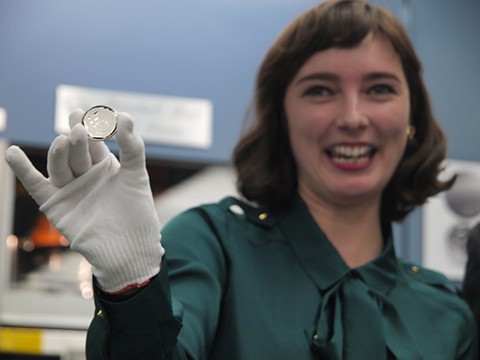
Curved coin artist Cassie McFarland
Leave it to San Francisco to be the hub of innovation in a function of government as old as the republic itself.
A never-before-used style of commemorative coin — the type of specie produced at the United States Mint in San Francisco — honoring the National Baseball Hall of Fame in Cooperstown, N.Y., will enter production soon.
Engraved with a design concocted by a 28-year-old San Luis Obispo artist, the coin has curved features that give it convex and concave heads and tails sides, respectively.
On the heads side of the new coin is a baseball, with a rounded edge as if the clad 50-cent piece were a real hardball.
And on the tails side is the glove design created by artist Cassie McFarland, which has a slight inward curve — just like a glove.
That familiar feel of the national pastime is what McFarland was trying to capture with her simple rendition of a regular, everyday symbol, she said Tuesday during a news conference at the Mint near Duboce Park.
McFarland, a visual artist who grew up in Roseville before graduating from Cal Poly — and a legitimate Giants fan — entered a U.S. Treasury contest to design the coin last year on “a whim,” she said.
She submitted her glove design on the last day before the deadline.
“I hate to say this, but I almost feel like it was my destiny,” she said. “The idea of the glove … it just clicked.”
It was no small feat for the creative coin to advance to the stamping stage: it took a special act of Congress to authorize the unique design, and further federal legislation to authorize the Mint to begin the process of stamping the coins, a Mint spokeswoman said.
The Hall of Fame coin goes on sale March 27, for a price yet to be determined, in 50-cent as well as $1 silver and $5 gold denominations.
To read the complete article, see: Baseball Hall of Fame commemorative coin produced by SF Mint (www.sfexaminer.com/sanfrancisco/baseball-hall-of-fame-commemorative-coin-produced-by-sf-mint/Content?oid=2730880)
HOW THE U.S. MINT MADE THE BASEBALL COIN
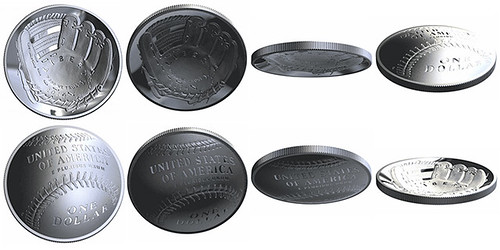
Later this month, the U.S. Mint will release a coin unlike any it’s ever made. Instead of being flat, it is shaped something like a bowl, with a convex surface that calls to mind a ball.
A baseball, to be precise.
The design, commemorating the 75th anniversary of the National Baseball Hall of Fame, bears the image of a baseball on one side. The obverse side, as it’s officially known, shows a baseball glove, gently curving inward. It’s a clever marriage of form and content, with the convex and concave sides lending the ball and the mitt a measure of three-dimensional realism. It’s also about as radical as coinage gets, and required an unprecedented effort by our nation’s money makers.
“This was like a moonshot for us,” says Stephen C. Antonucci, manager of digital development for the U.S. Mint in Philadelphia. “It stretched the bounds of everything we knew about coin development.”

The curved coin is not, however, the first of its kind anywhere. The bill that birthed the coin–The National Baseball Hall of Fame Commemorative Coin Act, signed into law by the 112th Congress on August 3, 2012–specifically references a curved coin issued by the French Mint, the Monnaie de Paris, to celebrate the International Year of Astronomy in 2009. When Antonucci’s team stepped up to the plate, the first thing he did was get his hands on one of those French coins.
 A laser scan created a 3-D model of the French original, giving the U.S. team a jumping off point for the general shape of the baseball coin. Despite its dome-like form, Antonucci says, the French coin is fairly two-dimensional in terms of how much its details pop off the surface. He decided that his creation would feature more pronounced relief, adding to the technical difficulty of the undertaking. “My nature’s very competitive in these types of things,” he says.
A laser scan created a 3-D model of the French original, giving the U.S. team a jumping off point for the general shape of the baseball coin. Despite its dome-like form, Antonucci says, the French coin is fairly two-dimensional in terms of how much its details pop off the surface. He decided that his creation would feature more pronounced relief, adding to the technical difficulty of the undertaking. “My nature’s very competitive in these types of things,” he says.
Typically, once a design is locked in, the mint sends off for master dies that are used to strike the coin in large quantities. It’s a tried-and-true system, but in this case, Antonucci couldn’t take anything for granted. Although master dies have stamped millions of coins over the years, every one of those coins was flat. Could a domed die handle the rigors of pressing and tooling? Could flat blanks be wrapped around a domed die in the first place, or would the ball and glove imagery need to be stamped onto pre-curved blanks? There was no way to tell until they tried.
The test runs went surprisingly well. Initially, the plan was to make only the gold and silver coins domed. But at some point, an order came down to make the clad, half-dollar coins (those that, like nickels, dimes, and quarters, have a copper core plated with nickel alloy) were to be curved as well. This was another challenge–Antonucci called the clad coin his “nemesis”–as introducing additional metals increased the risk of warping and die defects. But his team eventually got the kinks ironed out, tweaking the shape of the dome and the severity of the relief to make it all work. This coin is the first clad domed coin produced anywhere in the world.
The Congressional bill gave the mint permission to issue up to 50,000 $5 gold coins, 400,000 $1 silver coins, and 750,000 half-dollar clad coins. Prices will include an additional charge of $35 for each gold coin, $10 for each silver coin, and $5 for each half-dollar, with proceeds going to the National Baseball Hall of Fame. The coin will be released March 27.
The unique design will likely make the coin a hit with collectors. But for Antonucci, in a world defined by exacting specifications, where every detail is legislated, the dome was a rare chance to push his craft into new territory. The resulting tender, he says, is unlike anything you’ve held before. “This is gonna change things when you say, ‘let’s flip a coin.’”
To read the complete article, see: How the U.S. Mint Made Its First-Ever Domed Coin (www.wired.com/design/2014/03/u-s-mint-first-ever-domed-coin/)
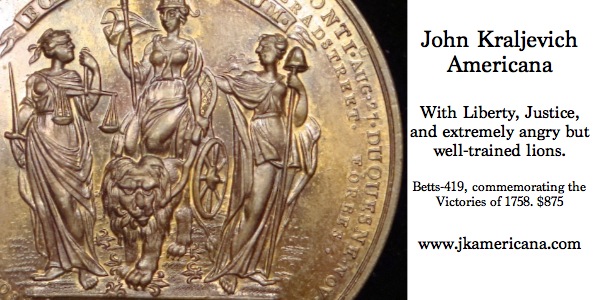
JOHN HUFFMAN AT THE INVASION OF LOUISVILLE
Ed Stoebenau recently purchased some numismatic books from John Huffman's estate, and was curious to learn what he looked like. With Charlie Davis' assistance, we identified John in The Money Tree's booklet of the Invasion of Louisville, the 1988 excursion to the library of Armand Champa.
Ed writes:
I recently acquired from a used bookstore John Huffman's copy of The Invasion of Louisville booklet (plus more books/catalogs to fill a few boxes). I did not know JH, nor as far as I know ever met him. I am thus curious as to anyone can point out which photos in the booklet he appears in, if any.
I've attached the cover and a random page. The photo captions don't identify the people in them. I can identify a few of them. John Burns was obvious, and I could pick out Ford and Newman though I've never met them. But I'm sure some E-Sylumite can identify John Huffman in one of the photos, and I suspect most of the copies of the booklet are owned by the readers here.

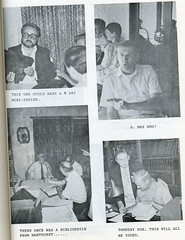
Sorry for the off-kilter images - Flickr's photo editor was acting up today. In the page of photos, that looks like Jack Collins (upper left), Bob Wester (upper right), Charlie Davis (bottom left), and Vince Alones and Del Bland (bottom right). I reached out to Charlie, and he forwarded a couple more images, and identified John Huffman for us. Thanks!
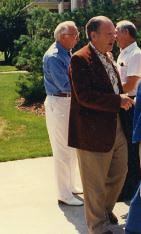

Above left is a scene in front of Armand's house, as everyone was getting off the bus that brought us to Louisville. That's John Ford in the white slacks, Eric Newman in the suit jacket, and Armand Champa in short sleeves. At right is a complete roster of attendees. John Huffman is listed as "Mr. Hoffman". (As always, you can click on the image to see a larger version in our Flickr archive).
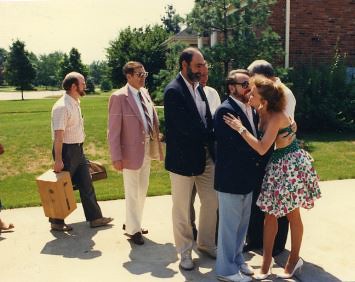
In this photo, that's John Huffman at the end of the receiving line carrying a box. At the front is Jack Collins getting a hug from Armand's wife Kay.
This sure brought back a lot of memories for me. It was John Burns who told me about the event and put me in touch with Armand. I talked my way into the gathering, even though I was only a fledgling numismatic literature collector. It was there for the first time I met hobby legends like John Ford, George Fuld, and Jules Reiver, not to mention every numismatic literature dealer in the country.
I think I'd met Eric Newman earlier. Regardless, it was the bombastic John Ford who held court and stole the show. His baritone voice could be heard all day long. Many of the great folks I met that day have since gone to meet their maker. But what a legendary gathering!
THE NEW YORK STAMP & COIN COMPANY

The dealers address indicates it was issued between 1889 and 1903. The token belonged to the late Steve Tanenbaum, and was sold by Dave Bowers, who is launching a full-color catalog with the Token and Medal Society of this neglected species of American exonumia.
In 1895 Augustus G. Heaton noted the coin dealership advertised on the store card in "A tour Among the Coin Dealers," published in an 1895 issue of The Numismatist.
According to Heaton, "The New York Stamp and Coin Company is located in a spacious room on the second floor of a large building on Union Square." Partners were H.P. Smith and David Proskey.
Harlan Page Smith, born March 18, 1839, was a wholesale fruit dealer before associating with numismatist Henry G. Sampson as Smith & Sampson, a short-lived numismatic auction firm, circa 1880 to 1881. From 1881 to 1887, Smith conducted 21 more auction sales on his own account, before entering into a partnership with Proskey in the later year.
David U. Proskey, born Dec. 12, 1853, had begun in the coin and mineral business as a 20-year-old in 1873. He cataloged for J.W. Scott and was editor for a dozen years of the firms monthly The Coin Collectors Journal. He also conducted several auctions on his own account before partnering with Smith in 1887.
The new partners conducted several of the eras most celebrated numismatic auctions, selling cabinets of R. Coulton Davis and Lorin G. Parmelee in 1890, Francis Doughty in 1891, and George Woodside and James Oliver in 1892.
To read the complete article, see: Spare Change: Advertising on embossed cards as a promotional vehicle (www.coinworld.com/insights/spare-change-advertising-on-embossed-cards-as-a-promotional-vehicle.html)
THE BOOK BAZARRE
BOSTON MUSEUM OF FINE ARTS ANCIENT COINS GALLERY
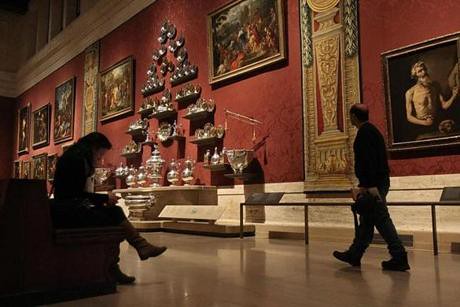
Magnifying devices, an interactive digital screen, and four iPads play a crucial role in a larger, nearby gallery dedicated to ancient coins. The Michael C. Ruettgers Gallery for Ancient Coins, which, like the gallery for ancient jewelry, opened in September 2012, has quickly become a favorite — especially with younger visitors who, thanks to books like Rick Riordan’s “Percy Jackson” series, tend to know their Greek myths better than many adults.
Coins open a window onto ancient history and mythology like few other objects. But they can be hard on the eyes and pose challenges to one’s powers of concentration. This new gallery’s open layout, its handy but unobtrusive technology, and its ingeniously straightforward labeling – not to mention the collection itself, which is stunning — conspire to make numismatists of us all.
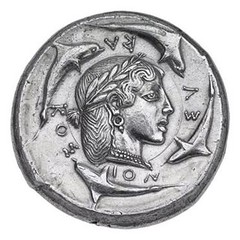 Among the coins are the world famous “Dekadrachm of Syracuse with quadriga” (circa 465 BC) — a Greek coin that also features Nike and a two-horse chariot — and a Roman denarius from 43-42 BC which boasts the head of Caesar’s assassin, Brutus, on one side, and the cap of liberty flanked by two daggers on the other.
Among the coins are the world famous “Dekadrachm of Syracuse with quadriga” (circa 465 BC) — a Greek coin that also features Nike and a two-horse chariot — and a Roman denarius from 43-42 BC which boasts the head of Caesar’s assassin, Brutus, on one side, and the cap of liberty flanked by two daggers on the other.
The gallery also includes wonderful related works and contextual information — everything from a large map of the Mediterranean to a lithograph showing studies of 12 ancient coins by the 19th-century French painter Eugène Delacroix.
To read the complete article, see: Small changes add up at the MFA (www.bostonglobe.com/arts/theater-art/2014/03/15/small-changes-add-mfa/fThrQHS6VsSJPnS6XgiAMM/story.html)
THE 500 EURO BIN LADEN BANKNOTE
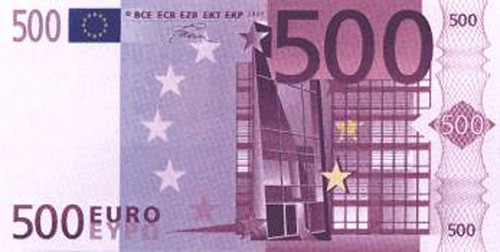
Spaniards call them Bin Ladens, and at the height of financial crisis in the fall 2008, it was the Bin Ladens that saved the day, says the former banknote chief for the European Central Bank.
Bin Ladens are the €500 banknotes. The joke about them being Bin Ladens surfaced in Spain four years after the euro banknotes were introduced in January 2002.
It played on the fact while everyone in Spain had heard about the big bill, nobody supposedly had seen one — even though it was reported that roughly a quarter of all €500 notes in the euro area circulated in Spain.
The joke has become outdated due to the snuffing out of Osama bin Laden. However, the debate whether the €500 bill should be eliminated lives on. The reason: critics say it is a boon to drug traffickers, money launderers and tax evaders.
The logic is simple. For $1 million in cash you need ten thousand $100 bills. With the €500 note, you need only about 1,450 banknotes for the same amount in cash at the current exchange rate. Handy if you need to store or transport big amounts of illicit cash. Thus the €500 should be withdrawn, goes the argument.
The debate is as old as the €500 note itself, recalls Antti Heinonen who was present at its creation. Mr. Heinonen chaired in 1996-1998 the EMI’s subcommittee which was tasked with creating the euro banknotes. EMI was the European Monetary Institute, the forerunner of the ECB.
From 1998 to 2008 he served as Director of Banknotes at the ECB, and was the point man at the introduction of euro banknotes in 2002.
The merits of high-value notes were debated in planning sessions, Mr. Heinonen said last week at the launch event for his new Finnish language book about the history of the first euro banknotes.
There were six countries with banknotes whose value exceeded €200: Holland, Belgium, Italy, Austria, Luxembourg and Germany with the most valuable high-denomination bill of them all, the 1,000 Deutsche Mark banknote valued at about €510.
As Mr. Heinonen recalled, representatives from these countries became upset when it was suggested that the high value banknotes helped the underground economy.
Defenders of the €500 note said that in some countries people preferred to keep savings in cash because they trusted it more than banks, Mr. Heinonen said.
That settled it. As for the legitimate uses for the €500, Mr. Heinonen mentioned one: a stabilizer during a financial crisis.
After the collapse of Lehman Brothers in 2008, public’s faith in banks wavered in many countries, sending people to exchange their savings for cash. Demand for the euro banknotes surged in and outside the euro area. “We could have not handled it without the €500 note,” Mr. Heinonen said.
To read the complete article, see: During Crisis the €500 Note, Beloved by Criminals, Saved the Day (blogs.wsj.com/economics/2014/03/17/during-crisis-the-e500-note-beloved-by-criminals-saved-the-day/)
IMPERIAL FABERGE EGG FOUND AT 'FLEA MARKET'
 There is good luck, outrageous good fortune — and now there is the case of the scrap metal dealer who found one of the eight missing Faberge imperial eggs at a flea market in the American Midwest.
There is good luck, outrageous good fortune — and now there is the case of the scrap metal dealer who found one of the eight missing Faberge imperial eggs at a flea market in the American Midwest.
A London antique dealer said Wednesday that that the scrap metal entrepreneur bought the egg for about $14,000, thinking he could make a small profit by reselling the piece for its gold content.
It turned out the jewel-encrusted piece was worth millions.
Kieran McCarthy of Wartski, which specializes in Russian artifacts, said the scrap metal dealer began to suspect he was holding a rare piece after seeing an article online about an imperial Faberge Easter egg made for Russian royalty.
The dealer contacted McCarthy, who verified the egg as genuine and negotiated its sale to a collector.
"The second I saw it, my spine was shivering," said McCarthy, calling the piece a "Holy Grail" for collectors.
Both buyer and seller want to remain anonymous, and McCarthy did not disclose the sale price — but experts note that a non-imperial Faberge egg sold at Christie's for $18.5 million in 2007.
To read the complete article, see: Scrap Dealer's Bargain Turns Out to Be Faberge Egg (www.nbcnews.com/news/us-news/scrap-dealers-bargain-turns-out-be-faberge-egg-n57131)

'MYSTERY SHOPPERS' RECRUITED TO PASS COUNTERFEITS
Two women from Georgia and West Virginia conned people, including at least two in Western Pennsylvania, into laundering counterfeit money orders and checks from Nigeria by telling them they were acting as “mystery shoppers,” according to court documents.
When the victims' banks learned the orders and checks were counterfeit, they demanded payment from the victims, prosecutors say.
The Nigerian conspirators would send bulk shipments of counterfeit U.S. Postal money orders, MoneyGram money orders and bank checks to Shawn Foote, 47, of Atlanta, prosecutors say.
Foote recruited Walker and Mason to help her con people into thinking they were acting as mystery shoppers when they used the counterfeits, with apparent values of $850 to $975, to make purchases.
To read the complete article, see: 'Mystery shoppers' conned with counterfeit money orders, checks, indictment says (triblive.com/news/adminpage/5791222-74/money-orders-counterfeit#axzz2wkIMNLFb)
MONEY ARTIST MARK WAGNER'S DOLLAR BILL COLLAGES
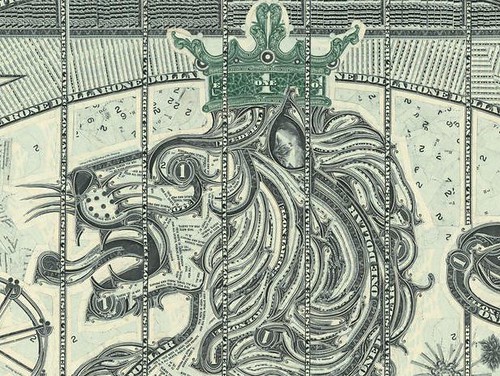
"Fit for a King"
Collage artist Mark Wagner had no idea where it would go when he first cut up a dollar bill 15 years ago. But he couldn't stop making things out of money. His collages are assembled entirely from one dollar bills -- and can fetch tens of thousands of dollars.
Wagner's work asks us to reconsider this piece of paper we value so much. His epic piece "Liberty" is 17 feet tall, made from nearly 82,000 bill fragments.
 The 42-year-old artist, who works out of his home in Lancaster, Pa., is a magician with an X-Acto knife and glue.
The 42-year-old artist, who works out of his home in Lancaster, Pa., is a magician with an X-Acto knife and glue.
He dissects dollars like in an autopsy, separating elements such as faces, signatures and numbers. Heads, for example, go in a Heads box.
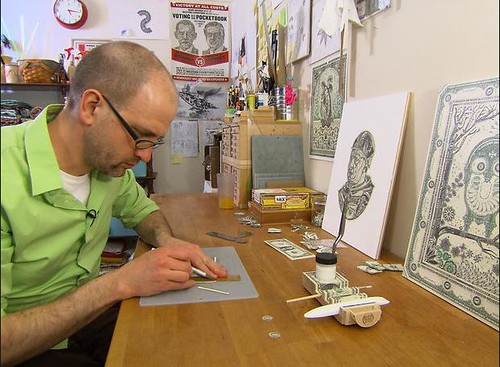
"Is it expensive to work with money?" asked CBS News correspondent Anthony Mason.
"It's not," replied Wagner. "The bills aren't the expensive part of the operation. It's the time -- that's the expensive part."
 In Wagner's world, Washington becomes Everyman ... and all the faces in the crowd.
"If I ever want an image of someone doing something, it's always George Washington," said Wagner. "He sort of stands in for everyone."
In Wagner's world, Washington becomes Everyman ... and all the faces in the crowd.
"If I ever want an image of someone doing something, it's always George Washington," said Wagner. "He sort of stands in for everyone."
"That's one of the ironies of the work," he told Mason. "People are so familiar with this object. They have their hands on it on a daily basis. And no one is really aware of what it looks like."
The very act of cutting up a dollar bill raises the question of what it's worth. Mark Wagner's art is a conversation about the nature of money and American identity: "I'm not making posters. I'm not making protest signs. You know, art happens in two places: Art happens in my brain when I'm making these things, and then in the viewer's brain, when they're looking at them. I'm interested in what everyone brings to the table."
To see the complete photo gallery, see: Made of money (www.cbsnews.com/pictures/made-of-money/)
To visit Mark Wagner's web site, see: http://markwagnerinc.com/
SLATE ARTICLE ON MONEY ARTIST MARK WAGNER
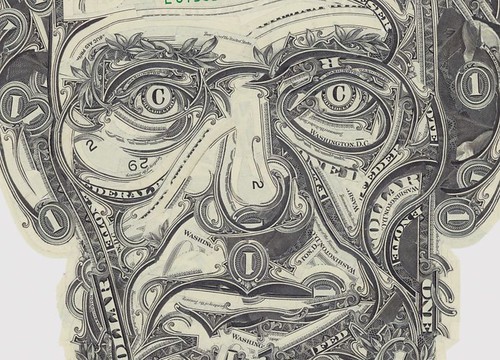
To make a currency portrait, Wagner starts with a pencil sketch on paper based on source material before painstakingly assembling the collages, sometimes working with an assistant, in a process that takes between 30 and 40 hours to complete.
In the early days, Wagner gathered his art supplies by hoarding dollar bills after breaking a $20 at the deli, but he has learned to plan ahead, ordering a fresh stack of 1,000 dollar bills from the bank. New “crispy” bills work best, he said, because the color of old bills can become dingy from too much handling. Plus, fresh singles lack the pungent odor of a well-circulated bill.
New bills, he said, have the scent of “production, of the press room, so there’s probably linseed oil and gum arabic and talc from the printing process.” Used dollar bills, on the other hand, are redolent with “the stink of a gym locker, just from people handling it.”
He said he sometimes puzzles out the design of a collage using photocopies of dollar bills so as not to throw money away on a rough draft.

To read the complete article, see:
How Collage Artist Mark Wagner Makes Portraits From Dollar Bills
(www.slate.com/blogs/the_eye/2014/01/14/collage_artist
_mark_wagner_currency_portraits.html)
CBS NEWS SEGMENT ON OLD AND NEW CURRENCY DESIGNS
These days American money is all about our celebrated statesmen: Washington, Lincoln, Franklin.
But once upon a time our currency was more adventuresome, featuring Native Americans, the Pilgrims, Martha Washington, and Lewis and Clark! And back at the end of the 19th century, there was an inventive line of bills known as the "Education Series."
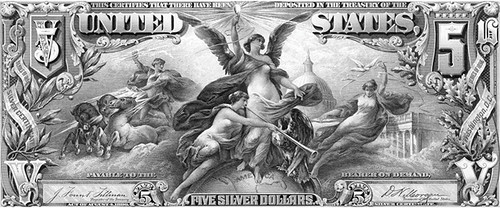
"The name of this particular design is actually 'Electricity presenting light to the world,'" said U.S. Treasurer Rosie Rios. "So you can see the allegorical figure, she's literally holding a light bulb."
We could understand why Rios (whose signature you'll find in your wallet today) looks back longingly at the money of yesterday.
Braver said, of the bills featuring cherubs and partially-clothed women, "To tell you the truth, this looks a lot more exciting than our current currency."
To read the complete article and view the video, see: Currency for a modern world (www.cbsnews.com/news/currency-for-a-modern-world/)
FEATURED WEB PAGE: COINS OF THE KINGS OF FRANCE
This week's Featured Web Page is a nice compilation of coins of the kings of France on Tom Oberhofer's site.
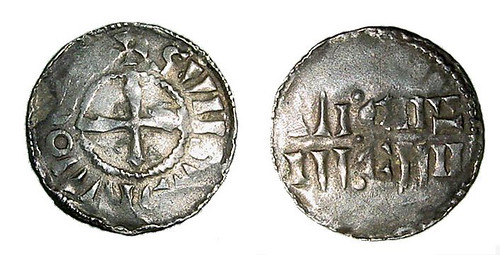
home.eckerd.edu/~oberhot/froy.htm
